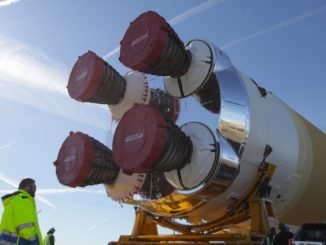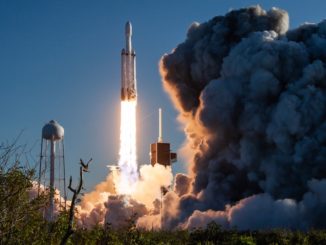
Update 8:30 p.m. EST: Intuitive Machines confirmed that the lander is upright and sending data.
In a day not seen since the Dec. 11, 1972, a lander built in the United States safely reached the surface of the Moon. Houston-based Intuitive Machines was to snap not only a more than 50-year absence from the U.S. on the lunar surface, but also a streak of commercial failures to make it safely to the Moon.
Intuitive Machines confirmed that it’s Nova-C lander, named Odysseus, landed at 6:23 p.m. EST (2323 UTC) Thursday evening at Malapert A, a crater about 10 degrees from Moon’s south pole. It takes place a week after launching onboard a SpaceX Falcon 9 rocket from NASA’s Kennedy Space Center on Feb. 15 at 1:05 a.m. EST (0605 UTC).
The landing was not without thrills and unexpected events. The landing was delayed about an hour after the originally announced time as additional software was uploaded to the lander that allowed one of the NASA payloads to be used in the landing procedure. It was a last-minute decision when some of the navigation sensors on the lander failed to operate as expected.
"We put the [Navigation Doppler Lidar for Precise Velocity and Range Sensing] as a tech demo and as a test, we weren't planning to use it… for the actual mission… but now we are. So, basically, it is the primary system to help provide the velocity and altitude information." —… pic.twitter.com/yLl4YuhBTC
— NASA Technology (@NASA_Technology) February 22, 2024
“What we can confirm, without a doubt, is our equipment is on the surface of the moon, and we are transmitting,” Mission Director Tim Crain told company flight controllers. “So congratulations, IM team! We’ll see how much more we can get from that.”
Once the lander was on the surface of the Moon, it took several minutes to try and establish a connection. Eventually, they turned to a communications receiver in the United Kingdom, Goonhilly Earth Station Ltd., which was able to provide confirmation of a signal, even though it was weak at first.
In his remarks following the launch, Intuitive Machines CEO Steve Altemus said that the propulsion system worked remarkably well and helped the lander touch down safely and vertically as intended.
Once the final burn, called the “powered descent initiation” began, the VR900 engine, which powered Odysseus, continuously burned all the way down. Prior to launch Altemus said they had high confidence in their 3D-printed engine.
“We build the engine combustion chamber, the engine injector and the engine ignitor all out of an Inconel, a high-nickel steel that we print in-house out of powder. And we laser center that powder and turn it into a real part,” Altemus said. “Which means I can build engines every five days, I have a new engine. And then, within five days of that, it’s all post-process and I can put it on the test stand and fire it.
“So, we were able to iterate time after time after time, building some 40 engines to get this one engine just right for this particular mission. So, that’s the advantage of our liquid oxygen, liquid methane engine.”

On the sidelines of an October 2023 conference in Huntsville, Alabama, Spaceflight Now spoke with Trent Martin, the vice president of Space Systems at Intuitive Machines. He said that the ability to repurpose the environments on other celestial bodies for fuel is the reason they went the route of using methalox.
“It is a clean-burning fuel that you can operate and test in a short-sleeve environment. It doesn’t require you to be in SCAPE (Self Contained Atmospheric Protection Ensemble) suits or anything like that. And, if you really think about ISRU, in-situ resource utilization, you would actually be able to create oxygen or create methane from the environment you’re at,” Martin explained.
“So, if you’re at the Moon, you obviously have water and you can create oxygen out of that. Great! I have a way that I can potentially refuel or run it over a carbon catalyst bed and create methane. At Mars, you already have methane. You have oxygen,” Martin added. “So, that’s why we believe it is the future. We used to call it the Conestoga wagon of space exploration.”
Martin harkened back to the resiliency of the engines used on NASA’s Project Morpheus, which were used between 2010 and 2014 to test vertical landing by teams at the Johnson Space Center. IM’s VR900 engine is born out of the work done by that team.
Martin wore several different hats at JSC from 2006 through 2015.
“On the Morpheus vehicle, the vehicle crashed on one of its test flights. We literally dug the engine out of the ground once it crashed and we re-flew that same engine,” Martin said. “So, it’s a very, very robust capability that we build in-house at Intuitive Machines.”
Back in October, Martin said they’d held more than 155 test days with their engine at their flame range in Houston. He said on each test day, they would run 5-7 tests. They had also tested around 39 variants of the engine up to that point as well.

One giant leap for private companies
With a successful landing of Odysseus on Thursday evening, Intuitive Machines cemented its place in history as the first commercially-built lander to safely touch down on the Moon in what’s known as a soft landing.
Previously, the governments of the United States, Russia, China, India and Japan have been the only nations to achieve a soft landing on the Moon.
Prior to this attempt by Odysseus, Israeli non-profit, SpaceIL; Japanese company ispace; and Pittsburgh-based Astrobotic all aimed their commercial landers at the Moon and all failed to reach their goal safely.

Both Astrobotic’s Peregrine and IM’s Odysseus are financially supported in part through NASA’s Commercial Lunar Payload Services program or CLPS (pronounced “clips”). They both carried a suite of science instruments onboard with the goal of furthering knowledge about the Moon in the run-up to sending humans to the surface through the Artemis program.
Joel Kearns, the deputy associate administrator for NASA’s Science Mission Directorate reiterated NASA’s more risk tolerate position with the CLPS program in the run-up to launch. He said while they certainly hoped IM would be successful with its first mission, the initiative would soldier on regardless.
“We’re looking to learn both from the first and the second flights of each of these same lander-type vehicles. NASA’s really a learning organization. So you can imagine after every mission, we look and we do lessons learned and we try to figure out how are we going to influence what we’re going to do in the future,” Kearns said. “So, we’re going to be watching attempts from all our CLPS providers and then making decisions based on that about how we see going forward.”
“We are committed to this model. We really think private-public partnerships are the right thing to do to further exploration of space,” Kearns added. “We would really like to be in a position, where if companies could do what they told us years ago they could do, which is that we could just buy the service, we would much rather buy the service than do things internally every time we do a mission at NASA, particularly to a place where there’s so much interest like the lunar surface.”



